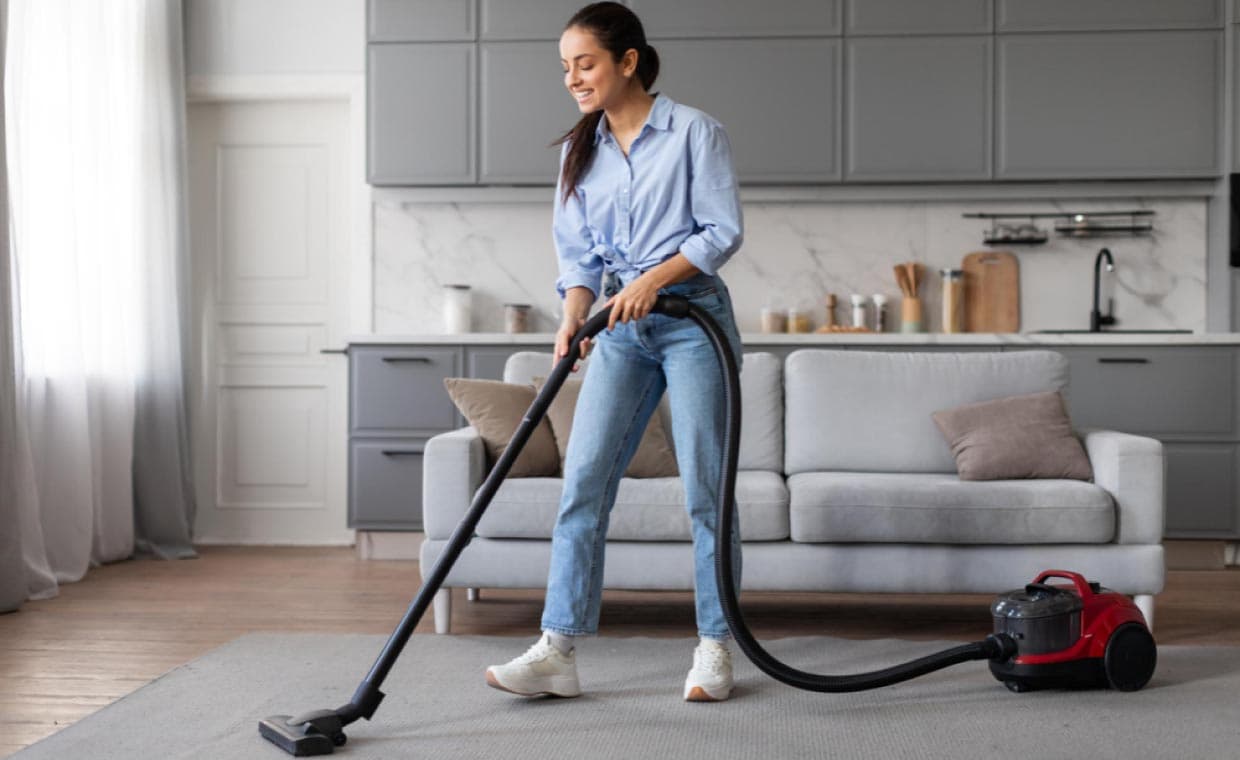
A vacuum cleaner is one of the most helpful appliances you can own because it makes cleaning your home faster. Unlike sweeping, which stirs up dust, vacuum cleaning captures dirt, debris, and allergens, making disposing of them easier and less troublesome.
A vacuum helps improve the air quality in your home, which is crucial especially if you or your loved ones have allergies and have a furry family member. This cleaning apparatus is highly effective in sucking dust, dander, and other allergens that can aggravate or trigger symptoms.
Modern vacuum cleaners come with attachments that allow you to clean more than just your floors. With this device, you can keep your upholstery, curtains, bookshelves, and even hard-to-reach corners dust- and dirt-free.
Using a vacuum also helps you save time and effort when cleaning your home. Instead of spending hours with a broom, dustpan, and dustcloth, a quick vacuum session leaves your home spotless within minutes.
Whether you have a small, mid-size, or large home, having a reliable vacuum cleaner lets you keep it clean, comfy, and healthy with less work.
How to Use Your Vacuum Cleaner More Efficiently?
Knowing how to use your vacuum correctly can help you clean your home more efficiently and quickly. Follow these vacuuming tips and tricks to use this cleaning apparatus more efficiently while saving time and effort:
01. Prepare the Area You Need to Vacuum

Clearing the area and giving surfaces a light dusting can make it easier to clean your space. Start by removing obstacles such as small furniture (chairs and coffee tables), toys, and shoes. Doing so can speed up the process and ensure you don’t miss any spots.
With less clutter in the way, you’ll be able to glide through rooms more smoothly and reach tricky corners easily.
As you vacuum, air movement can stir up dust on shelves, tables, or window sills. Wiping these areas and other surfaces before doing this chore can minimise the particles that fly around and land on freshly cleaned floors.
Clearing and dusting may require additional work, but they can make a noticeable difference in your cleaning routine.
02. Get Your Vacuum Cleaner Ready

If you haven’t used your vacuum for several days, take the time to check and prepare it for use.
Empty the bag or box if you’re using a water vacuum cleaner to ensure it collects dust, dirt, and debris without the need to stop in the middle of the chore to do this. Also, make sure the filters are clean to get the best results.
Additionally, connect the attachment you need to use first and place the others somewhere you can easily reach them.
When you’re ready to begin, choose the appropriate cleaning mode on your vacuum. If you’re cleaning low-pile carpets, opt for high suction to avoid pushing dust and dirt into the tufts or backing.
If you have hardwood flooring, use the flat head attachment and stream mode to clean it well.
03. Follow a Pattern When Vacuuming

If you want a thoroughly clean carpet, avoid running the vacuum in a back-and-forth motion. The best technique is to move it forward in structured rows.
Start by vacuuming a row of the carpet in one direction, from one wall to the other. Run the vacuum against a carpet nap first to fluff it up and make embedded dirt come up easier.
If the carpet piles look a bit darker or are sticking up, you’re vacuuming against the nap correctly.
After you reach the other side, run the vacuum over the strip you just cleaned. Doing so helps flatten the piles and suck up remaining dirt and dust.
When you reach the other end, vacuum another straight line next to the first strip you cleaned. Continue following the pattern until you’ve vacuumed the entire room.
Once you’re done, vacuum the floor in the opposite direction. If you did it from south to north the first time, do it east to west now.
Vacuuming your carpet twice and following a pattern ensures you have a thoroughly clean floor. You can also follow this tip with other types of flooring.
Remember to take your time as you vacuum and avoid quick movements as well to have a spotless floor.
04. Use the Right Attachment for Particular Cleaning Tasks

Vacuum cleaners have attachments that help you clean certain areas and surfaces in your home. Make sure you are familiar with them and how to use them.
Below is an overview of the common vacuum attachments and where to use them:
- Crevice Tools – used for reaching tight corners and narrow spaces, including crevices between cushions and baseboards.
- Upholstery Tools – these include upholstery brushes, which are used for cleaning sofas, chairs, drapes, curtains, and other features with fabric surfaces.
- Extension Wands – these attachments help you vacuum high places and fixtures, such as ceiling fans or lights, without the need to use a ladder.
05. Vacuum Regularly

Instead of waiting until dirt and dust become noticeable, make vacuuming a routine.
Dirt and dust accumulate quickly in high-traffic areas, such as hallways, entrances, the kitchen, and the living room. They can stick to carpets and rugs, making it more difficult to remove them the longer you leave them alone.
Frequent vacuuming helps prevent this buildup and keeps your floors looking fresh with less effort.
Additionally, regular vacuuming can reduce allergens in your home. Dust, pet dander, and pollen can settle on floors, which can trigger allergies and contribute to poor indoor air quality.
When you make a habit of vacuuming at least once or twice a week, you can remove these irritants before they circulate in the air or settle deeply into carpets, rugs, and upholstery.
06. Maintain Your Vacuum Cleaner

A well-maintained vacuum cleaner performs better and lasts longer. As such, take care of this cleaning device once you bring one home.
Start by emptying the dust bag or box after every use. When this part is full, the vacuum’s suction power decreases, which makes it less effective.
Filters tend to get clogged, which can restrict airflow and reduce the machine’s efficiency. Clean them regularly or replace them when needed, as recommended by the manufacturer.
Also, check the brush roll regularly for tangled hair or threads that can prevent it from spinning properly. Inspect the hoses and attachments for blockages to ensure your vacuum runs at peak performance.
When you follow these tips, you can have an easier time vacuuming and keeping your home clean, cosy, and beautiful.
Also Read: Purchasing a Vacuum Cleaner? Here’s What to Look For






























